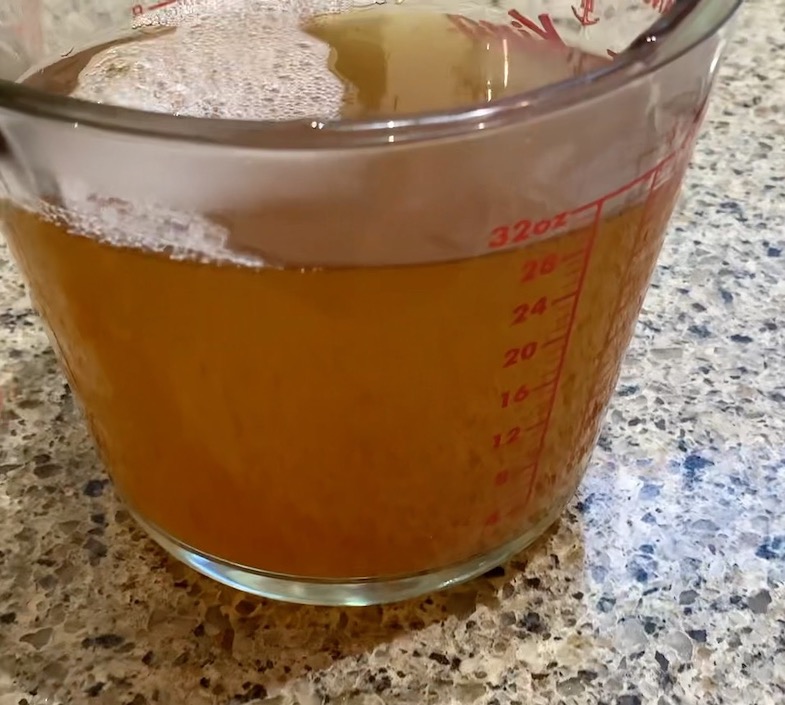Gluten-Free Dashi Recipes
Share
Making Japanese dashi (soup broth) is easy. It is naturally gluten-free, but as always read the ingredients labels. Here are two recipes that I use all the time.
The above photo shows 4 cups (1 litre) of finished dashi. Don't worry about the bubbles on top, they will go away. I had just strained the katsuobushi and those are air bubbles.
The first is super simple and I use this quite often for making the dashi broth used in miso soup recipes, soba noodle broth recipes and other Japanese recipes that call for dashi broth. This isn't really a recipe, it is just water and dashi powder (granules). I like to use Ajinomoto's Hondashi bonito soup stock.

(1)Gluten-Free Japanese Dashi using Dashi Powder
Ingredients
- 4 cups water
- 2 teaspoons dashi powder
Directions
- In a medium saucepan add your water and dashi powder. Bring to a boil and it is done.
- The dashi broth is ready to use in miso soup or as the base for a soba broth.
The second dashi recipe is a slight bit more complicated, but still easy to make. You need to buy some katsuobushi (bonito fish flakes) and some kombu (dried kelp). Don't throw away the used kombu and katsuobushi as you can use them in other recipes. For example, I fry the used katsuobushi in a little sugar and gluten-free soya sauce and use in the middle of onigiri (Japanse riceballs).

(2)Gluten-Free Japanese Dashi using Katsuobushi and Kombu
Ingredients
- 4 cups water
- 2 cups (30 grams) loose packed katsuobushi (dried bonito flakes)
- 20 grams kombu (dried kelp)
Directions
- Measure out your ingredients.
- In a medium saucepan put the 4 cups of water and the kombu. Bring to a boil, then turn off the heat and remove the kombu. the kombu should have expanded in size and be soft. Some people like to leave the kombu in the warm water for 5 to 10 minutes to make a stronger broth, but I like to remove it right away as I find it can make the broth bitter. Don't throw the kombu out as you can use it to make other recipes.
- Now add the katsuobushi flakes and bring the water back up to a boil, then simmer on low heat for about 3 minutes. Drain the broth and reserve the cooked katsuobushi to use in other recipes.
Japanese dashi is a basic must have in your pantry for making a variety of Japanese dishes. Miso soup, clear broth soups, nabes (hotpots) and noodle soup broths. You can keep in the fridge for about 3 days or in the freezer for 3 months. I sometimes freeze the broth in old ice cube trays and put the dashi cubes in a ziplock bag to use when I need them. Or I always have the dashi powder on hand and that is super convenient.
Now what to do with the katsuobushi bonito flakes that you just used for making the broth? I put them in a dry frying pan on low heat and cook until most of the moisture is gone. You will need to keep stirring the flakes. Add a pinch of sugar, about a teaspoon of gluten-free soy sauce, and a teaspoon of mirin or sake (optional), and cook and stir until the liquid is absorbed. You can now use the flavoured katsuobushi as a furikake to sprinkle on rice or put in the middle of onigiri (riceballs).
For the used kombu I make kombu tsukudani. Just cut the kombu into thin strips and put into a small pot. To the pot add 1/2 cup of water, 1 tablespoon of sake and mirin, 2 to 3 tablespoons gluten-free soy sauce, 1 teaspoon of sugar and 1 teaspoon of rice vinegar. Bring to a boil, then turn down the heat and simmer until the liquid has been absorbed. Stir frequently. Sprinkle with some toasted sesame seeds and serve in a bowl as a side dish to rice.
Note: These are my personal experiences and opinions. Always seek out a medical opinion for medical concerns. Not sponsored. If sponsored I will always say so at the top of the post.